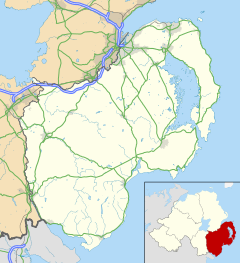Portavogie
Portavogie
|
|
|---|---|
| Portavogie shown within County Down | |
| Population | 2,122 (2011 Census) |
| District | |
| County | |
| Country | Northern Ireland |
| Sovereign state | United Kingdom |
| Post town | NEWTOWNARDS |
| Postcode district | BT22 |
| Dialling code | 028 |
| EU Parliament | Northern Ireland |
| UK Parliament | |
| NI Assembly | |
Portavogie (from Irish Port a' Bhogaigh, meaning 'harbour of the bog') is a village, townland and fishing port in County Down, Northern Ireland. It lies within the Borough of Ards and is the easternmost settlement in Ireland. It had a population of 2,122 people in the 2011 Census.
The town has a modern harbour, housing a large fishing fleet catching mainly prawns and herrings. Most evenings there are fish auctions on the quays. Three murals on the exterior of the local school celebrate the history of the fishing industry in the town.
In about 1555 there was a settlement at Stable Hole to the north of where Portavogie now stands, at the bottom of what is now the Warnocks Road. The site was chosen for the shelter provided by the surrounding rocks and the sandy shore on which the inhabitants could beach their boats; they existed on what they could grow and catch. This was the first settled area south of Ballyhalbert (Talbot's Town) and in the main the inhabitants were families of fishermen who had travelled from across the Irish Sea from the Solway Coast. In those days the Ardes was an area of marsh land and bog and was in a world of its own to the rest of Ireland. Public records from 1620 name the area as Portabogagh from the Gaelic Port a' Bhogaigh. As with all names, pronunciation leads to different spelling and in time this became Portavogie, this spelling first recorded in 1810.
With no strategic benefit in developing Portavogie the Anglo-Normans ignored the immediate area and concentrated on developing the castles at Quintin, Ardkeen, Portaferry and Ballygalget. The entrance to Strangford Lough became a strategic defence area and was rich in seafish providing a ready source of food.
Portavogie was protected from the east by the Irish Sea and to the west by the "Bogs", an area still known as that today. The route north to Newtownards was low lying and subject to regular flooding at spring tide. At one time there were 82 windmills the length of the Ards Peninsula; this must have looked as the Netherlands does today and probably gave rise to the epithet "Little Holland". The Savage family had controlled the Ards from around 1200 but did little to improve the area, instead concentrating on securing their ownership and defences.
...
Wikipedia

